Archive for the ‘Glaciology’ Category
06/04/2012
Mountaineer and Filmmaker Dave Breashers presents Rivers of Ice, Vanishing Glaciers of the Greater Himalaya

Before and After Shots..Not Good.
The Greater Himalaya has the largest concentration of glaciers outside the polar ice sheets, providing vital fresh water for almost every major system of Asia. Over the past five years, Breashears and the team of his nonprofit organization, GlacierWorks, has conducted ten photographic expeditions to the region, to study and document the effects of climate change on this delicate landscape.

Dave Breashears
Breashears presents at the Boston Museum of Science on April 12, but alas, tickets are sold out. Nevertheless we thought it was worth the post here. You might try to try the climber’s move and squeeze in somewhere.
Retracing the steps of pioneering alpine photographers and explorers George Mallory, Vittorio Sella and others, Breashears and the team have captured high-definition photographs that match those of the earliest expeditions. By comparing this contemporary imagery with the historic photographs, Breashears and his team are discovering staggering changes to the region—changes with potentially devastating consequences.
There is debate in the scientific community about the rate and extent to which Himalayan glaciers are shrinking. Nevertheless, scientists agree that there is a trend of melting beyond what is expected to occur naturally. Although future impacts of glacial melt cannot be known, any disruption to the water supply will inevitably present challenges to the millions of people living downstream.
Breashears plans on sharing his work in a blend of first-person story telling and imagery.
More info: Mount Washington Observatory
Thursday, April 12, from 6:30 to 9:30 pm
Museum of Science, Boston
Tags:Asia, before & after, before and after, Climate Change, Dave Breashears, expedition, Glaciaology, Greater Himalaya, melting glaciers, Mount Washington Observatory, Mountain Spirit, Mountaineering, photographs, Rivers of Ice
Posted in Asia/Himalaya, Climate Change, Climb/Ski/Mntneering, Environment, Glaciology, Traveling | Leave a Comment »
20/04/2011
From: The Guardian
John Vidal reports from La Paz where Bolivians are living with the effects of climate change every day. Their president has called for an urgent 50% cut in emissions – action that is essential for the country’s survival. Click on the image to view video.

Excellent Video on Bolivia�s Iniatives
Tags:Climate Change, Equal Rights for Earth Mother, Evo Morales, Mother Earth, Mountain Spirit
Posted in 1- Video Posts, Climate Change, Environment, Film/DVD, Glaciology, Indigenous Wisdom, Inspirational People, Leadership, Power of Place, South America, Sustainable Living/Communities | Leave a Comment »
06/05/2010
Imagine A World Without Fish
Ocean acidification threatens over one million species with extinction–and with them, our entire way of life.

Time for Course Corrections
DVD: Directed by Barbara Ettinger
Recipient of the NOAA 2010 Environmental Hero Award
A Sea Change documents how the pH balance of the oceans has changed dramatically since the beginning of the Industrial Revolution: a 30% increase in acidification. With near unanimity, scientists now agree that the burning of fossil fuels is fundamentally reshaping ocean chemistry. Experts predict that over the next century, steady increases in carbon dioxide emissions and the continued rise in the acidity of the oceans will cause most of the world’s fisheries to experience a total bottom-up collapse–a state that could last for millions of years. Read more..
Directed by Barbara Ettinger
Produced by Barbara Ettinger, Sven Huseby, Susan Cohn Rockefeller
Music by Joel Goodman
Tags:Climate Change, DVD, Ocean Acidity, Sea Change
Posted in Climate Change, Conservation, Environment, Film/DVD, Glaciology, Leadership, Power of Place | Leave a Comment »
07/06/2009
Is there a link between Frozen Woolly Mammoths and Pole Shift?
When I first read parts of John White’s 1980 book, Pole Shift, what left an indelible mark on me, was reading the link between the green veggies found the stomachs of frozen woolly mammoths and possibility of relatively rapid shiftings of the earth’s magnetic poles called “pole shift”. Then again, maybe I didn’t read correctly, as the excerpts from an old nhne.com article indicate below, where White is interviewed by David SunFellow.

- Pole Drift
I’m not well versed on the subject, but from what limited knowledge I do have on the subject, I find the the correlations interesting. Also, the way that the poles are “drifting” more every year, (also according to NASA scientist turned author/mystic Gregg Braden) has my attention. According to Braden, airports are having to repaint their runway compass coordinates so often, that some have stopped the procedure. (Check out his books, two of which are The Isiah Effect and Awakening to Zero Point.)
Pole Shift Torpedoed by Author
By David Sunfellow
When John White first published “Pole Shift” in 1980, his book sent re-affirming shocks waves through the earth changes community. Many (including this reporter)

- White mentions Mammoths
believed White’s book “proved” that Edgar Cayce, and a host of others, had correctly foreseen a global catastrophe that would destroy much of the planet along with major portions of the human race. White’s book was particularly powerful because it was written by a man with serious professional credentials and, perhaps more importantly, because it seamlessly wed modern scientific data with contemporary psychics and ancient myths and prophecies. While White refused to say in “Pole Shift” that he was absolutely certain that a pole shift was coming, he left no doubt that he thought one might strike sometime near the year 2000.
Now, however, White has publicly said that he doesn’t believe there is going to be a pole shift — at least the kind of cataclysmic variety envisioned by Cayce, Gordon-Michael Scallion, and others. (more…)
Tags:Apollo 14, David Sunfellow, Dexter Randall Richards, ecospiritual psychology, Edgar Mitchell, Experiential Education, Frontiers of Consciousness, Frozen Mammoth, Holistic Living, Institute of Noetic Science, link to pole shift, Mountain Spirit, Mountaineering, mtnspirit.org, New Hampshire, New Zealand, nhne.org, Peru, Pole Shift, Spiritual, Sunapee, Sustainability, Utah
Posted in Books, Climate Change, Environment, Glaciology | 1 Comment »
05/06/2009

Near The Sunshine Route-Bergshrund Mt. Hood
I was a senior staff trainer at Outward Bound for their Instructor’s Alpine Courses on Mt. Hood. We were finalising a week of training with a successful summit climb. But on the ascent, there was one of those moments, when learning from experience could have been painful but wasn’t, because the outcome was positive. We were climbing the Snow Dome, on Mt. Hood’s northwest side, on the final approach to the Sunshine Route. I had been leading and training staff on this route for a few years prior, so was relatively familiar with the route, crevasses and bivy sites.

Site not far from snowbridge collapse
We set out from high camp on the snow dome early on a cloudless sunny day, a crisp snap in the spring air, crampons crunched the snow underfoot. I decided to let the trainees lead out on ropes of four, with one trainer per rope team. There were three rope teams, and my team was in the back, with taking up the final position. It was easy ground, and once we got to the base of the steeper terrain at the start of the Sunshine route, we’d rearrange the order.
Before setting off, we first decided who would lead out. I then briefed him on the route, which generally followed the crest of the snow dome, but (more…)
Tags:Bergshrund, Dexter Randy Richards, Glacial recession, Glacier Travel, Mountain Spirit, Mountaineering, Mt. Hood, Outdoor leadership, Outward Bound, Pacific Crest Outward Bound, Route finding, routefinding, Snow bridge collapse, Snow Dome, Staff Training, Sunshine Route
Posted in Climb/Ski/Mntneering, Conservation, Environment, Glaciology, Leadership | 1 Comment »
16/05/2009
From New Zealand to Utah, From Alaska to New Hampshire – Ice bergs to Honeycombs
It’s called calving, when a glacier’s edge dramatically breaks off. Many cruise ships take the tour along Alaska’s shores. From Seward and other harbors along the coast, one can sign on for a daily round-trip to get up close views.

Perito Mereno Glacier, Argentina
The dramatic Perito Mereno Glacier in Argentina’s Southern windswept Los Glaciares National Park has many visitors.and is possibly the most famous rivers of ice in the world because. It was declared a World Heritage site by UNESCO in 1981. Amanda and I stopped at Tasman Lake in New Zealand’s Mt. Cook National Park to see the floating ice bergs in the grey-green water thick with rock flower. We hiked up to the top of an old terminal moraine and saw the bergs as the sun was setting.

White Pine Lake, Utah
More than a few times, I’ve jumped into such frigid waters, after a run or back country mountain sleep, just to wake me up. While at University of Utah, when I was still learning about the mountains, I did an overnight up White Pine Canyon in the late fall and jumped into White Pine Lake near Snowbird. A few minutes later, it had a skim of ice on it. That’s chilly, but there were no icebergs or calving going on, just shivering.

Lake Tasman, Mt. Cook
The Tasman Glacier regularly claves ice bergs but the evening we were there it was calm and each iceberg gave us a show of *“petreflections” of various sizes and patterns.
When the ice goes out in Lake Sunapee, NH, the reader may be curious to know that there usually aren’t big ice bergs. Then again, I didn’t grow up on the west side of the lake, where the whole lot piles up on a windy afternoon leaving dramatic piles of ice, as if the town dump truck and just deposited its backlog for the winter. On the east side of the lake, we observe the ice gradually thinning from the spring melt, and as it thins, darkens to almost a black. It turn into “honeycomb ice” we call it, where its transformed from the meter-thick solid sheet that runs the whole lake, to fragile, loosely held together elongated splinters that fall apart when scooped up in your hand. Those of us that grew us as kids along the shore of a lake will know what I mean. Daily we watch the progression.

*Petreflections Galore
Official Ice Out day is declared when Artie Osborne can take his boat from the north tip at George’s Mills to Newbury, some 10-13 miles distant without obstruction. To my knowledge, he still makes the trip, and in the process, closes the informal town bets for the season. Go swim in an ice-berg filled lake sometime. It’s the right thing to do.
Author’s Note: Also see my earlier entry on largest iceberg breaks off of Tasman Glacier in 100 years.
*Petreflections: A term coined by Kathy Lowe. See her link above.
Tags:adventure travel, Alaska, Argentina, Arthur Osborne, Dexter R. Richards, ecospiritual psychology, Experiential Education, Georges Mills, Holistic Living, Ice Bergs, Kathy Lowe Bloch, Little Cottonwood Canyon, Los Glaciares National Park, Mountain Spirit, Mountaineering, Mt. Cook National Park, mtnspirit.org, New Hampshire, New Zealand, Newbury NH, Petroflections, Randy Richards, Sunapee NH, Sustainability, UNESCO, Utah, White Pine Canyon
Posted in Environment, Glaciology, New Zealand, Power of Place, South America, Traveling | Leave a Comment »
06/05/2009
Secrets of 37,000 year old baby mammoth revealed
By Paul Rincon – BBC

Baby Mammoth
Perfectly preserved, the baby mammoth looks like she has been asleep only for a moment – not for the 37,000 years she has spent locked in the rock hard permafrost of the Arctic tundra.
Clumps of brown hair still cling to the three foot tall body, hinting at the coarse coat that would have once covered the infant. Even her eylasahes are intact.
These extraordinary images show why scientists are so excited by the discovery of Lyuba – the most complete body of a woolly mammoth ever found

Area where Mammoth was Found
Discovered at the side of a river by reindeer herders on the Yamal Peninsula in northwest Siberia, the bone month old female is helping scientists to unravel how the extinct ice age giants once lived.
The contents of her stomach have provided scientists with valuable clues about what she and her fellow mammoths ate.
The baby’s layers of fat and minerals in her teeth have provided an unprecedented insight into her health and the health of her herd.
Palaeontologists now believe the information they have gleaned from the remains can help them understand what led to the woolly mammoths’ ultimate extinction around 10,000 years ago.

Mammoth Mummy
It is thought that mammoths died out as they were unable to adapt to the changing world around them as temperatures soared at the end of the last ice age, although some experts believe they may have been hunted to extinction by humans.
The findings have shown that the baby mammoth was in good health and well fed before its death, suggesting that its herd was able to find plenty of food at the time it was alive.
(more…)
Posted in Animals, Archeology, Environment, Glaciology | 6 Comments »
18/03/2009
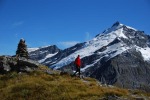
The View from French Ridge Hut
I recently had the opportunity to volunteer at French Ridge Hut last week. We had an unusual clear spell of almost cloudless blue skies, day after day. More times than not, the wind can howl on this ridge, making it difficult to make the journey to the privy, perched on the ridge, (so helicopters can more easily pick up the poop canisters).
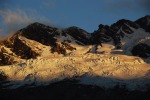
Near Mt. Avalanche-Gloomy Gorge
I recently heard of one fellow who was sent to his death when the hut he was in, was blown off the mountain. I’m sure some of the readers have been on a fire lookout tower in high winds, having complete trust in the structure. Hmmm. Makes one think. Be sure to inquire or check to see if the hut you’re in has tie-down cables. French Ridge does not. I trust the architect, up to a point. It depends on how strong are the gale force winds. This is a bit tongue in cheek, or ice axe in ground.
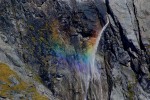
Waterfall Rainbow, Gloomy Gorge
French Ridge and the environs is a magical place. It’s getting a lot of traffic from hikers as well as climbers. I was there later in the season, (just last week), when traffic to and from the Collin Todd Hut, and Mt. Aspiring had been halted due to the Quarterdeck section of glacier coming down from the Bonar Glacier was breaking up too badly to allow passage.

Monkeying around on the "Quarter Deck"
We decided to monkey around on the lower ramparts of the Quarterdeck anyway, for a day of walking, crevasse rescue and rope team travel practice, and a little bit of climbing in some dramatic scenery. While we were rather restricted in where we could actually go, we still had fun. The dry glacier provided some great ice climbing practice. I love glacier ice, which is a far cry from New
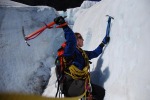
More playing around on some "safe" broken up bits.
Hampshire’s Frankenstein Cliff’s. I’ve just read a piece on climbing on the Fox Glacier that has me interested in doing some glacial ice there.
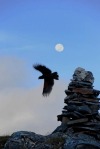
Kea in Flight
At the hut and just above, Keas, which are amazing Alpine parrots, seemed our constant companions. I figuring out when they would take off, and got some snaps of them in flight. One, at the hut, the other with Mt. Avalanche in the background just above the hut. They are very personable and curious creatures, if not troublesome. When we arrived at the hut on Day 1, the door to the was open, and the keas had made themselves at home, leaving the place a mess.
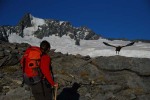
Kea, Amanda, Mt Avalanche
Just across from the Hut, on the ramparts of Rob Roy, is an impressive waterfall. It’s interesting and beautiful because the water comes piling down and hits a flat plateau, shooting the water out into space, like a jet stream. Then when the sun is hitting the wall just right, a rainbow is formed.
Tags:adventure travel, Alpine Parrot, Brenda Dowst, Dexter R. Richards, ecospiritual psychology, Experiential Education, French Ridge, Glacier Travel, Gloomy Gorge, Holistic Living, Ice Climbing, Kea, Mountain Spirit, Mountaineering, Mt. Aspiring, mtnspirit.org, New Hampshire, New Zealand, Quarter Deck, Randy Richards, Spiritual, Sunapee, Sustainability
Posted in Climb/Ski/Mntneering, Environment, Glaciology, MSI News, New Zealand, Power of Place, Traveling | Leave a Comment »
26/02/2009

Wilken River, Makarora BC, NZ
Kerin Folks Flat on the Wilkin River is about an hour into an eight-hour trek to the Top Forks Hut area. I’ll include more images of that area soon, but felt I had to post this image ASAP. “Rock flour” colours the water the brilliant turquoise blue that is visible in this image. Rock flour is a result of the glacier a few miles upriver, dragging and grinding rocks and stones between the bottom of the glacier and the ground. The curious color of the fine powder that comes out of the glacier’s terminus is the subject of many a tourist’s query. So I’ve been told, rock flour is simply mud that hasn’t been exposed to the air. Once exposed, after a number of years, it turns brown. In any event it sure makes for good images. This is probably one of my favorite, even after being a professional photographer for a number of years.
Top Forks is a remote part of Aspiring National Park, right in the center of the park, accessible from the Makarora West village area. The highlight of the Top Forks valley is Mt. Castor and Mt. Pollux from which hanging glaciers drop house-sized ice blocks throughout the day and night, making a roaring sound heard from the hut.
Tags:adventure travel, Bob Stremba, Brenda Dowst, Cindy Heath, Dexter R. Richards, ecospiritual psychology, Experiential Education, Glaciology, Kerin Forks Hut, Makarora, Mountain Spirit, Mountaineering, mtnspirit.org, New Zealand, Peru, Rock Flour, Spiritual, Sunapee, Sustainability, Top Forks Hut, Wilkin River
Posted in Environment, Glaciology, New Zealand | 5 Comments »






















